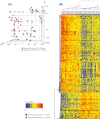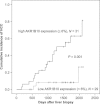Up-regulated aldo-keto reductase family 1 member B10 in chronic hepatitis C: association with serum alpha-fetoprotein and hepatocellular carcinoma
- PMID: 22681639
- PMCID: PMC3466415
- DOI: 10.1111/j.1478-3231.2012.02827.x
Up-regulated aldo-keto reductase family 1 member B10 in chronic hepatitis C: association with serum alpha-fetoprotein and hepatocellular carcinoma
Abstract
Background: Elevated serum alpha-fetoprotein (AFP) is not only a diagnostic marker for hepatocellular carcinoma (HCC), but is also a risk factor for HCC in chronic hepatitis C patients who do not have HCC.
Aim: The aim was to analyse the hepatic gene expression signature in chronic hepatitis C patients with elevated AFP, who were at high risk for HCC.
Methods: Liver tissue samples from 48 chronic hepatitis C patients were stratified by their serum AFP levels and analysed for gene expression profiles. The association between aldo-keto reductase family 1 member B10 (AKR1B10) expression and serum AFP was confirmed by quantitative real-time reverse transcription polymerase chain reaction (qRT-PCR) and immunohistochemical analyses. A matched case-control study was performed to evaluate the risk of AKR1B10 expression for HCC development.
Results: Distinct hepatic gene expression patterns were demonstrated in patients with elevated AFP (≥10 ng/mL) and normal AFP (<10 ng/mL). Of the 627 differently expressed genes, the most abundantly expressed gene in patients with elevated AFP was AKR1B10 (fold change, 26.2; P < 0.001), which was originally isolated as an overexpressed gene in human HCC. The qRT-PCR and immunohistochemical studies confirmed a proportional correlation between AKR1B10 expression and serum AFP. A matched case-control study identified that AKR1B10 up-regulation (>6%) was an independent risk factor for HCC development (hazard ratio, 21.4; P = 0.001).
Conclusion: AKR1B10 was up-regulated in association with serum AFP, and was an independent risk factor for HCC in chronic hepatitis C patients, suggesting its possible involvement at a very early stage of hepatocarcinogenesis.
© 2012 John Wiley & Sons A/S.
Figures




Similar articles
-
Impact of aldo-keto reductase family 1 member B10 on the risk of hepatitis C virus-related hepatocellular carcinoma.J Gastroenterol Hepatol. 2016 Jul;31(7):1315-22. doi: 10.1111/jgh.13295. J Gastroenterol Hepatol. 2016. PMID: 26758591
-
A Large-Scale Multicenter Study Validates Aldo-Keto Reductase Family 1 Member B10 as a Prevalent Serum Marker for Detection of Hepatocellular Carcinoma.Hepatology. 2019 Jun;69(6):2489-2501. doi: 10.1002/hep.30519. Epub 2019 Apr 6. Hepatology. 2019. PMID: 30672601 Free PMC article.
-
Pretreatment AKR1B10 expression predicts the risk of hepatocellular carcinoma development after hepatitis C virus eradication.World J Gastroenterol. 2016 Sep 7;22(33):7569-78. doi: 10.3748/wjg.v22.i33.7569. World J Gastroenterol. 2016. PMID: 27672277 Free PMC article.
-
Clinical value of AKR1B10 in hepatocellular carcinoma: A systematic review and meta-analysis.PLoS One. 2022 Dec 30;17(12):e0279591. doi: 10.1371/journal.pone.0279591. eCollection 2022. PLoS One. 2022. PMID: 36584078 Free PMC article.
-
An Insight Into the Role of Alpha-Fetoprotein (AFP) in the Development and Progression of Hepatocellular Carcinoma.Mol Biotechnol. 2024 Oct;66(10):2697-2709. doi: 10.1007/s12033-023-00890-0. Epub 2023 Oct 2. Mol Biotechnol. 2024. PMID: 37782430 Review.
Cited by
-
Genomic variants link to hepatitis C racial disparities.Oncotarget. 2017 Aug 1;8(35):59455-59475. doi: 10.18632/oncotarget.19755. eCollection 2017 Aug 29. Oncotarget. 2017. PMID: 28938650 Free PMC article.
-
Metallothionein 1M suppresses tumorigenesis in hepatocellular carcinoma.Oncotarget. 2017 May 16;8(20):33037-33046. doi: 10.18632/oncotarget.16521. Oncotarget. 2017. PMID: 28380433 Free PMC article.
-
Identification of a role for serum aldo-keto reductase family 1 member B10 in early detection of hepatocellular carcinoma.Oncol Lett. 2018 Dec;16(6):7123-7130. doi: 10.3892/ol.2018.9547. Epub 2018 Oct 3. Oncol Lett. 2018. PMID: 30546447 Free PMC article.
-
Serum AKR1B10 as an indicator of unfavorable survival of hepatocellular carcinoma.J Gastroenterol. 2023 Oct;58(10):1030-1042. doi: 10.1007/s00535-023-02011-9. Epub 2023 Jul 27. J Gastroenterol. 2023. PMID: 37500927
-
Regulation of aldo-keto-reductase family 1 B10 by 14-3-3ε and their prognostic impact of hepatocellular carcinoma.Oncotarget. 2015 Nov 17;6(36):38967-82. doi: 10.18632/oncotarget.5734. Oncotarget. 2015. PMID: 26516929 Free PMC article.
References
-
- EI-Serag HB, Rudolph KL. Hepatocellular carcinoma: epidemiology and molecular carcinogenesis. Gastroenterology. 2007;132:2557–76. - PubMed
-
- Fattovich G, Stroffolini T, Zagni I, Donato F. Hepatocellular carcinoma in cirrhosis: incidence and risk factors. Gastroenterology. 2004;127:S35–50. - PubMed
-
- Kiyosawa K, Umemura T, Ichijo T, et al. Hepatocellular carcinoma: recent trends in Japan. Gastroenterology. 2004;127:S17–26. - PubMed
-
- Fattovich G, Giustina G, Degos F, et al. Morbidity and mortality in compensated cirrhosis type C: a retrospective follow-up study of 384 patients. Gastroenterology. 1997;112:463–72. - PubMed
-
- Niederau C, Lange S, Heintges T, et al. Prognosis of chronic hepatitis C: results of a large prognostic cohort study. Hepatology. 1998;28:1687–95. - PubMed
Publication types
MeSH terms
Substances
LinkOut - more resources
Full Text Sources
Medical

